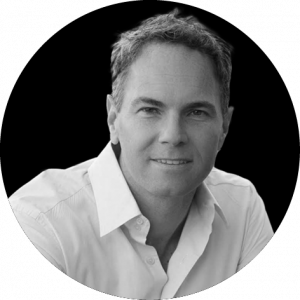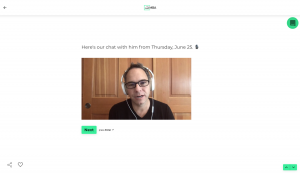
I learned that from Chris Barton in the Power MBA
Career, founded companies & learnings by Chris Barton
Career:
Do you still remember 1999? When you could only do 3 things with mobile phones: write SMS, make calls and download the 8-bit playback of Shaggy as a ring tone. During this time, Chris was already working on a mobile phone function that could not really be used until 2007 with the first iPhone.
Chris Barton was a pioneer. The idea of Shazam was way ahead of its time. In an interview when asked what he would have done differently in retrospect, he replied: “In an ideal world, Shazam would have started about five years later. So we would have missed the more difficult times – while we waited for cell phones to catch up with our vision. “
5 Learnings from Chris Barton
That teaches me how pointless it is to work on a company for the sake of money. I can only master challenges if I stand behind what I do with passion and heart and soul.
3. The right people. To make Shazam a reality, Chris and his partners were looking for a programmer for their music recognition software. They didn’t just put up a job advertisement and hope for the best. They searched for 9 months. In doing so, they compiled a list of 20 specialists in this field. Sorted the 5 brightest minds out of it and then slide their No. 1 at. The founders were not only good at their fields, they also shared the same passion, drive and integrity – which ultimately led to success.From this I draw how important it is to get the right people into your team. It’s not just about talent, it’s also about passion. And to find these people, it is not enough to wait for them.
4. Minimum Viable Product. To get investors excited about Shazam, the founders initially programmed a simple version of their later software. So they were able to demonstrate it on some pieces of music during the presentation. They tried to keep their expenses as low as possible.That showed me how important it is to achieve the greatest effect with little effort, especially at the beginning. So to develop a minimum viable product *. (* literally a “minimally executable product” – is a product that covers customer, market or functional requirements with little effort.)
5. Think outside the box. Chris could have developed a service that scoured the radio stations’ playlists for a piece of music they were looking for. Just like the other music recognition services. But he doesn’t. He kept thinking. So he came up with the idea that there had to be software that recognizes the songs by their sound. At that time, such software was still unthinkable. With this way of thinking, Chris set a milestone that no one could take away from him so quickly.The story of Shazam shows me that only those who revolutionize can have resounding success.
 The story of Shazam
The story of Shazam
Shazam is known today as the music recognition app. Based on an acoustic fingerprint, it can analyze audio sequences and thus display the title and other information. It all started long before the App Store and Google Play existed.
The Shazam founders developed music recognition technology in 1999 that previously seemed impossible.
In 2002 they introduced the world’s first mobile music recognition service. To use this, you called a speed dial number. The music was recorded during the call. The call ended automatically after a few seconds. If the melody matched one from the database, the user received an SMS with the title.
In 2008 the app came into the AppStore. In 2017, Apple sold the company for an estimated $ 400 million. Shazam now has over 100 million app users per month.
You can learn that from Chris Barton at the Power MBA:

- How he came up with the idea of Shazam
- How much he values the choice of his co-founders
- Why did he believe in his idea
- How he got investors during the dotcom bubble
- How to avoid expenses in the beginning
- Tips on how to be a good CEO
Start Your PMBA*
The life story of Chris Barton

Chris Barton’s interest in technology was piqued early on.
When he was about eleven, his mother brought home a Sinclair computer. On this, one of the first PCs, he taught himself how to write simple software programs.
He loved business and computer technology and knew that he would later marry his two passions. During his studies at UC Berkeley, he took economics and many courses in computer science.
He got to know the co-founders of Shazam, Dhiraj Mukherjee and Philip Inghelbrecht, at this time.
After meeting his fellow student who was about to open an Internet real estate business that later went public. (ZipRealty) sparked the desire for his own company.
During his MBA exchange program, he studied at the London Business School for a few months. There he experienced a real wow factor. In a class called Strategic Innovation, he learned the importance of thinking outside the box in order to create real and sustainable innovations in the business world.
He brainstormed for an idea for his company that would be revolutionary and saw the potential that cell phones would create a whole new world of possibilities.
Already at that time there was the possibility for users to call up a song that was being played on the radio. To do this, however, the radio station had to be specified, whereupon the station’s playlist was searched. However, Chris tried to think beyond the idea of radio surveillance software. And that is when the idea of Shazam was born. Chris Barton wanted a technology that recognizes a song recorded with a mobile phone based on its sound. This is how it should work everywhere, not just on the radio.
This may sound obvious to you and not particularly innovative. In 1998, a technology that was supposed to recognize music was science fiction.
Chris Barton founded and developed the business idea and technology together with Philip Inghelbrecht, Avery Wang and Dhiraj Mukherjee in 1999. Shazam later caught the interest of Apple, which bought the technology for a speculated $ 400 million in 2017. With over 1 billion downloads, the app is one of the most popular apps on iPhone and Android Datum today.
Chris’s career has also spanned companies like Google, where he worked for 8 years, and Dropbox, where he was director of business development for wireless operators.
He is currently starting a new startup focused on machine learning and computer vision.
 The story of Shazam
The story of Shazam